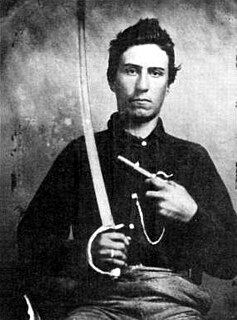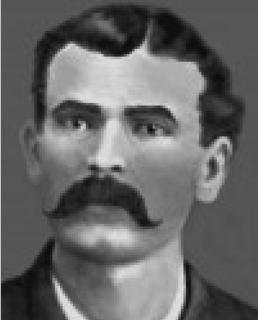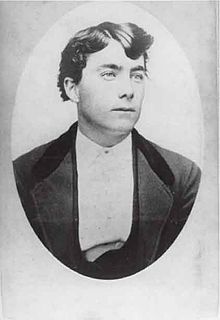
The gunfight at the O.K. Corral was a 30-second shootout between lawmen led by Virgil Earp and members of a loosely organized group of outlaws called the Cowboys including Ike Clanton that occurred at about 3:00 p.m. on Wednesday, October 26, 1881, in Tombstone, Arizona Territory, United States. It is generally regarded as the most famous shootout in the history of the American Wild West.

Wyatt Berry Stapp Earp was a gambler and Old West lawman in the American West, including Dodge City, Deadwood, and Tombstone. He took part in the famous gunfight at the O.K. Corral, during which lawmen killed three outlaw Cochise County Cowboys. He is often erroneously regarded as the central figure in the shootout, although his brother Virgil was the Tombstone City and Deputy U.S. Marshal that day, and had far more experience in combat as a sheriff, constable, marshal, and soldier.

John Peters Ringo, known as Johnny Ringo, was an American Old West outlaw loosely associated with the Cochise County Cowboys in frontier boomtown Tombstone, Arizona Territory. He took part in the Mason County War during which he committed his first murder. He was arrested and charged with murder, but escaped from jail shortly before his death. He was affiliated with Cochise County Sheriff Johnny Behan, Ike Clanton, and Frank Stilwell during 1881–1882. He got into a confrontation in Tombstone with Doc Holliday and was suspected by Wyatt Earp of having taken part in the attempted murder of Virgil Earp and the ambush and death of Morgan Earp. Ringo was found dead with a bullet wound to his temple. Modern writers have advanced various theories attributing his death to Wyatt Earp, Doc Holliday, Frank Leslie, and Michael O'Rourke.

William Brocius, better known as Curly Bill Brocius, was a gunman, rustler and an outlaw Cowboy in the Cochise County area of the Arizona Territory during the late 1870s and early 1880s. His name is likely an alias or nickname, and some evidence links him to another outlaw named William "Curly Bill" Bresnaham, who was convicted of an 1878 attempted robbery and murder in El Paso, Texas.

Fort Rucker, or Camp Rucker, is a former United States Army post in Cochise County, Arizona. First known as Camp Supply and Camp Powers, its name was changed on October 1, 1878 in honor of Lieutenant John Anthony "Tony" Rucker. On July 11, 1878, Lieutenant Rucker died in an unsuccessful attempt to save the life of a fellow soldier, Lieutenant Austin Henley, when the two tried to cross a nearby river which had swelled following a rainstorm.

The Earp Vendetta Ride was a deadly search by a federal posse led by Deputy U.S. Marshal Wyatt Earp for a loose confederation of outlaw "Cowboys" they believed had ambushed his brothers Virgil and Morgan Earp, maiming the former and killing the latter. The two Earp brothers had been attacked in retaliation for the deaths of three Cowboys in the Gunfight at the O.K. Corral on October 26, 1881. From March 20 to April 15, 1882, the federal posse searched southeast Cochise County, Arizona Territory for the men they believed were responsible for the attacks on Virgil and Morgan. Several suspects had been identified and were charged, but were soon released by the court, owing in some cases to legal technicalities and in others to the strength of alibis provided by Cowboy confederates. Wyatt hoped that the legal system would bring the Cowboys to justice, but after suspects in both ambushes were freed, Wyatt resolved to take matters into his own hands.
"Turkey Creek" Jack Johnson was an American bookkeeper, lawyer, cattle handler and lawman. He rode with Wyatt Earp as a member of the posse during the Earp Vendetta Ride.

John Wilson Vermillion (1842–1911), also known as "Texas Jack" or later as "Shoot-Your-Eye-Out Vermillion", was a gunfighter of the Old West known for his participation in the Earp Vendetta Ride and his later association with Soapy Smith.
Sherman McMaster (1853–1892) was an outlaw turned lawman, who was one of the six men involved in the Earp vendetta ride.

Frederick G. White was an American lawman and the first town marshal of the mining boomtown of Tombstone, Arizona Territory. White was elected to the position on January 6, 1880. At the time, Tombstone was still an emerging frontier town with fewer than 1,000 residents, and did not become an official city, with over 1,000 residents, until a year later. Before that time, White died in office following a notorious accidental shooting, and was succeeded by Virgil Earp.

Contention City or Contention is a ghost mining town in Cochise County in the southeastern part of the U.S. state of Arizona. It was occupied from the early-1880s through the late-1880s in what was then known as the Arizona Territory. Only a few foundations now remain of this boomtown which was settled and abandoned with the rise and fall of silver mining in and around the area of Tombstone.
The Skeleton Canyon massacres refer to two separate attacks on Mexican citizens in 1879 and 1881. Skeleton Canyon is located in the Peloncillo Mountains, which straddles the modern Arizona and New Mexico state line border. This canyon connects the Animas Valley of New Mexico with the San Simon Valley of Arizona.

Frank McLaury born Robert Findley McLaury was an American outlaw. He and his brother Tom owned a ranch outside Tombstone, Arizona, Arizona Territory during the 1880s, and had ongoing conflicts with lawmen Wyatt, Virgil, and Morgan Earp. The McLaury brothers repeatedly threatened the Earps because they interfered with the Cowboys' illegal activities. On October 26, 1881, Tom, Frank, and Billy Clanton were killed in the Gunfight at the O.K. Corral.

Tom McLaury was an American outlaw. He and his brother Frank owned a ranch outside Tombstone, Arizona, Arizona Territory during the 1880s. He was a member of a group of outlaws Cowboys and cattle rustlers that had ongoing conflicts with lawmen Wyatt, Virgil, and Morgan Earp. The McLaury brothers repeatedly threatened the Earps because they interfered with the Cowboys' illegal activities. On October 26, 1881, Tom and Frank were both killed in the Gunfight at the O.K. Corral in Tombstone, Arizona Territory. The Tombstone shootout was his only gunfight.
Charles "Pony Diehl" Ray was an Old West outlaw in the New Mexico Territory and Arizona Territory. He was accused by Wyatt Earp of having taken part in an attempt to kill his brother, Virgil Earp. Diehl was not tried due to a lack of evidence.

The Cochise County Cowboys were a loosely associated group of outlaw cowboys in Pima and Cochise County, Arizona Territory in the late 19th century. The term cowboy had only begun to come into wider usage during the 1870s, and in the place and time, Cowboy was synonymous with rustler. Cattle thieves frequently rode across the border into Mexico and stole cattle from Mexican ranches, which they drove back across the border and sold in the United States. Some modern writers consider them to be one of the first and earliest forms of organized crime syndicates in American history.

Cochise County in southeastern Arizona was the scene of a number of violent conflicts in the 19th-century and early 20th-century American Old West, including between white settlers and Apache Indians, between opposing political and economic factions, and between outlaw gangs and local law enforcement. Cochise County was carved off in 1881 from the easternmost portion of Pima County during a formative period in the American Southwest. The era was characterized by rapidly growing boomtowns, the emergence of large-scale farming and ranching interests, lucrative mining operations, and the development of new technologies in railroading and telecommunications. Complicating the situation was staunch resistance to white settlement from local Native American groups, most notably during the Apache Wars, as well as Cochise County's location on the border with Mexico, which not only threatened international conflict but also presented opportunities for criminal smugglers and cattle rustlers.

Robert Havlin "Bob" Paul was a law enforcement officer in the American Southwest for more than 30 years. He was sheriff of Pima County, Arizona Territory from April 1881 to 1886 and a friend of Deputy U.S. Marshall Virgil Earp and his brother Wyatt Earp. At 6 feet 6 inches (1.98 m) and 240 pounds (110 kg), he was described as "larger than life". Others described him as "powerful, fearless and very lucky".
Frederick J. Dodge was an undercover Wells Fargo detective, a constable in Tombstone, Arizona, and a Texas cattleman. He was born in Spring Valley in northern Butte County, California and was raised in Sacramento.

Dan Tipton was an American sailor, miner, gambler, and member of a federal posse led by American Old West lawman Wyatt Earp. He participated in Earp's vendetta during which four outlaw Cowboys were killed.














